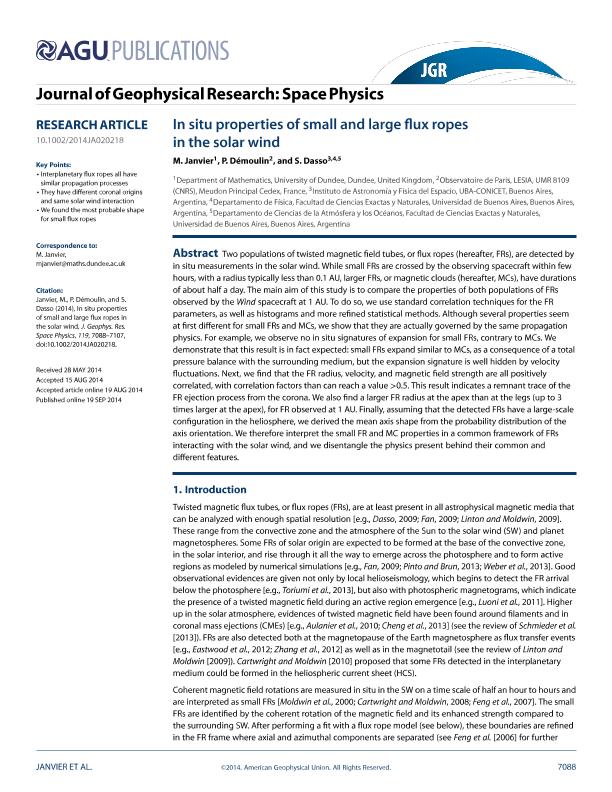Mostrar el registro sencillo del ítem
dc.contributor.author
Janvier, M.
dc.contributor.author
Démoulin, Pascal

dc.contributor.author
Dasso, Sergio Ricardo

dc.date.available
2017-05-10T21:33:42Z
dc.date.issued
2014-09
dc.identifier.citation
Janvier, M.; Démoulin, Pascal; Dasso, Sergio Ricardo; In situ properties of small and large flux ropes in the solar wind; American Geophysical Union; Journal Of Geophysical Research; 119; 9; 9-2014; 7088-7107
dc.identifier.issn
0148-0227
dc.identifier.uri
http://hdl.handle.net/11336/16256
dc.description.abstract
Two populations of twisted magnetic field tubes, or flux ropes (hereafter, FRs), are detected by in situ measurements in the solar wind. While small FRs are crossed by the observing spacecraft within few hours, with a radius typically less than 0.1 AU, larger FRs, or magnetic clouds (hereafter, MCs), have durations of about half a day. The main aim of this study is to compare the properties of both populations of FRs observed by the Wind spacecraft at 1 AU. To do so, we use standard correlation techniques for the FR parameters, as well as histograms and more refined statistical methods. Although several properties seem at first different for small FRs and MCs, we show that they are actually governed by the same propagation physics. For example, we observe no in situ signatures of expansion for small FRs, contrary to MCs. We demonstrate that this result is in fact expected: small FRs expand similar to MCs, as a consequence of a total pressure balance with the surrounding medium, but the expansion signature is well hidden by velocity fluctuations. Next, we find that the FR radius, velocity, and magnetic field strength are all positively correlated, with correlation factors than can reach a value >0.5. This result indicates a remnant trace of the FR ejection process from the corona. We also find a larger FR radius at the apex than at the legs (up to 3 times larger at the apex), for FR observed at 1 AU. Finally, assuming that the detected FRs have a large-scale configuration in the heliosphere, we derived the mean axis shape from the probability distribution of the axis orientation. We therefore interpret the small FR and MC properties in a common framework of FRs interacting with the solar wind, and we disentangle the physics present behind their common and different features.<br />
dc.format
application/pdf
dc.language.iso
eng
dc.publisher
American Geophysical Union

dc.rights
info:eu-repo/semantics/openAccess
dc.rights.uri
https://creativecommons.org/licenses/by-nc-sa/2.5/ar/
dc.subject
Interplanetary Flux Ropes
dc.subject
Space Weather
dc.subject.classification
Astronomía

dc.subject.classification
Ciencias Físicas

dc.subject.classification
CIENCIAS NATURALES Y EXACTAS

dc.title
In situ properties of small and large flux ropes in the solar wind
dc.type
info:eu-repo/semantics/article
dc.type
info:ar-repo/semantics/artículo
dc.type
info:eu-repo/semantics/publishedVersion
dc.date.updated
2017-05-02T20:13:32Z
dc.journal.volume
119
dc.journal.number
9
dc.journal.pagination
7088-7107
dc.journal.pais
Estados Unidos

dc.description.fil
Fil: Janvier, M.. University of Dundee; Reino Unido
dc.description.fil
Fil: Démoulin, Pascal. Centre National de la Recherche Scientifique. Observatoire de Paris; Francia
dc.description.fil
Fil: Dasso, Sergio Ricardo. Consejo Nacional de Investigaciónes Científicas y Técnicas. Oficina de Coordinación Administrativa Ciudad Universitaria. Instituto de Astronomia y Física del Espacio. - Universidad de Buenos Aires. Facultad de Ciencias Exactas y Naturales. Instituto de Astronomia y Física del Espacio; Argentina
dc.journal.title
Journal Of Geophysical Research

dc.relation.alternativeid
info:eu-repo/semantics/altIdentifier/doi/http://dx.doi.org/10.1002/2014JA020218
dc.relation.alternativeid
info:eu-repo/semantics/altIdentifier/url/http://onlinelibrary.wiley.com/doi/10.1002/2014JA020218/abstract
Archivos asociados
